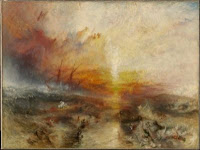 |
| Van Gogh, Self Portrait, 1889, NGA |
Although Vincent van Gogh’s painting of himself, titled Self Portrait, 1889, located in the National Gallery of Art, was not painted outdoors, the use of dabs of pure color and emphasis on light are characteristics of Impressionist painters. Around his head and upper body, thick textured brushstrokes create a circular motion. The background color is a similar shade as the blue in his shirt. From far away, the background and shirt seem to blend together. The different brushstrokes used separate the shirt from the background because the strokes within the shirt are long and wavelike. As the eye comes closer to the painting, it is clear that Van Gogh does not use just one color. He blends together different shades of blue, green, black and white to form his vibrant strokes. The white emphasizes the seam in Van Gogh’s right shoulder because it is lighter than the other colors. The painting’s back left is a little greener, showing the reflection of light across the canvas.
In his self-portrait, Vincent van Gogh uses brushstroke and color to express a gloomy emotion. His face appears gaunt, and his blue eyes are vacant. There is no emotion coming from his face; he is blank. By using formal qualities to express emotion, rather than the subject, Van Gogh seems disconnected from the viewer. Even though his face is turned left, looking out at the audience, he avoids direct eye contact. His furrowed brows and tight lips show that there is something on his mind. The tension in his face is further emphasized by expressive brushstrokes because they look like wrinkles. His face has a greenish hue, contrasting with his red hair, perhaps indicating that something is not right. The dominant use of blue also adds to the painting’s sad, emotional tone. The formal characteristics of the painting seem to relate to Van Gogh as a person. He was mentally unstable, famous for cutting off his ear and sending it to a woman. The thick, curvilinear brushstrokes and blue coloring of his self-portrait show how he used color and line to express his instability.
*Picture: http://www.nga.gov/education/classroom/self_portraits/bio_van_gogh.shtm















